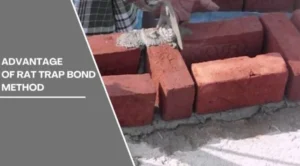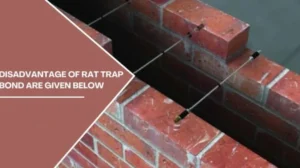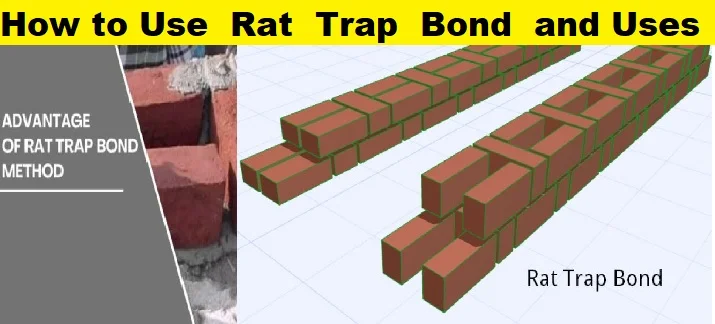What is the Rat Trap Bond:
This is one way to build a wall with brickwork on wall construction. This way of laying bricks is a little different from other ways and works on the principle of making holes.
It means there is space between two blocks when they are placed on a layer. In this method, the bricks are in a vertical position, so the side with fog stays on the inside, which is hollow because the bricks are in a vertical position.
The main goal of this idea was to bring down the cost of building materials as much as possible. At the same time, it also reduced the number of materials needed and is much better at keeping the heat in than the older brick masonry method. The most important thing to remember is that this method doesn’t change the wall’s strength.
How to Practically Use Rat Trap Bond Method?
- People who are used to the traditional way of brickwork are less likely to use this method. At the moment, these ways of building with stone are new in many places.
- In this type of bricklaying pattern, the bricks are placed on the edges. This means that the side with the fog stays inside the wall, and four blocks are used to make a small rectangular section.
- Because of this, the wall has a space or void inside, which is a key part of getting good thermal insulation in the room.
Rat Trap Bond Method Advantage

- Below is a list of the few benefits. This method is flexible because it uses less building materials, which means it saves money on building materials.
- Compared to traditional masonry, this method uses about 30% less bricks and 50% less mortar.
- Most people don’t use this method because they don’t know about it. But the strength is the same as an old way to lay bricks.
- If you look at thermal insulation as the main benefit of this method, it helps lower room temperature and saves money on electricity.
- This method of laying bricks is a key part of how well a building can stand up to heat and cold.
- This pattern of bricklaying is eye-catching from both the inside and the outside of the wall. Plastering can be skipped if it is not necessary.
- Well, this method of laying bricks is also used to make a partition wall, and the fact that it can hold weight doesn’t change the fact that it can hold weight.
- This method is very helpful for lowering the cost of materials. It cuts down on the amount of materials used, which saves money in the construction budget.
Rat Trap Bond Method Disadvantage

Here are some of the bad things about rat trap bond methods.
- This method of building is not strong enough to stop sound. So, this is not a way to make a soundproof wall.
- When putting down bricks, a mason has to be careful. When designing the length and height of walls for a building, extra care must be taken.
- Needs training first If the workers didn’t know how to lay bricks in this pattern if that wasn’t possible, they hired experienced workers. As a result, the cost of a worker may go up.
Points to Consider in Construction Rate Trap Brick Bonds
When using this pattern, you should be careful about the following:
- First, the quality of the bricks is always checked before they are used. Good bricks have even sizes and sharp edges.
- The first layer at the bottom and the last layer at the top of the wall should not have any vertical bricks.
- Other parts, like the sill and lintel levels at the opening or the sides of the opening, must be solid, so it’s easy to give frames for doors and windows strength.
- If the building needs more power, we can use reinforcement bars to put vertically in hollow spaces, corners, and around doorways to protect the building from the effects of an earthquake.
- In this case, installing electrical appliances and plumbing pipes took a lot of planning and smart work.
- When you add everything up, this way of building saves about 25% of the cost of the traditional 9-inch brickwork used to build a building of the same value.
- Based on an experiment or survey, it took 350 bricks per CFM with the old method, but only 250 with this one. The amount of mortar used also went down, so it has a direct effect on building budgets.
Using the rat trap bond to build walls

The rat trap bond is a method of laying bricks when building a wall. It’s similar to the common “Flemish” bond, but instead of putting the bricks on their faces, they are placed on their edges. This means fewer bricks and cement are needed, which reduces embodied energy of the wall.
I plan to use rat trap walls in the ShKo bungalow in Karjat, and I wanted to know how much of a thermal difference they would make. Nobody seems to have done the math on the difference, or at least I couldn’t find anyone who had. So, I tried to do that using data from the thermal calculator and the energy evaluation part of ArchiCAD.
I did a calculation for each type of wall using a simple 3m x 3m structure with no openings. Result: Compared to regular walls, the average U-value of the building’s outer shell dropped by about 15%, and the amount of energy needed to cool the building also dropped by about 8%. The difference was bigger than it really was because the model’s walls were shaded by the roof.
Still, 8% isn’t something to laugh at when you think about it. Also, the energy that goes into making the wall is cut down by a lot, and Laurie Baker’s original reason for using the rat-trap bond still stands: building the wall is cheaper.
FAQs
Bonded Rat Trap
A rat trap bond is a way to build a wall with bricks. Instead of laying the bricks horizontally, as is usually done, they are placed vertically, making a hollow space inside the wall.
What Is the Purpose of Rat Trap Bond?
A rat trap bond is a way to build a wall with bricks. Instead of laying the bricks horizontally, as is usually done, they are placed vertically, making a hollow space inside the wall.
Can Rat Trap Bond Support Weight?
Rat trap bonds can be used to build both load-bearing walls and thick walls that separate rooms. The rat trap bonding method is pretty long-lasting, and it costs less to keep up.
Masonry Rat Trap Bond
Rat trap bond is a type of modular masonry bond in which the bricks are set up vertically, making a hole in the wall while keeping the same thickness as a normal brick masonry wall. A Chinese brick bond is another name for it.
Who Created Rattrap Bond?
Laurie Baker, a well-known architect, came up with and made the rat-trap bond popular. This system uses bricks on the edges, and each face brick has a space behind it. Each course of brickwork is 115mm high and is made up of two parallel faces and a brick placed at a 90° angle to lock the bond. In the next course, the locking brick is used to break the vertical mortar joints by spanning the hole in the middle of each one. A brick-on-edge is used to fill the space in a T or L junction to make it solid. Horizontal courses of brick-on-edge can be put below the damp-proof course (DPC) or at the lintel and roof levels to provide horizontal tying. For every 230 mm brick height, one layer of mortar can be saved.
Rat Trap Wall
A rat trap bond is a way to build a wall with bricks. Instead of laying the bricks horizontally, as is usually done, they are placed vertically, making a hollow space inside the wall.
Rat trap bond wall
Rat trap bond is a type of modular masonry bond in which the bricks are placed vertically, making a hole in the wall while keeping the same thickness as a regular brick masonry wall. A Chinese brick bond is another name for it.


